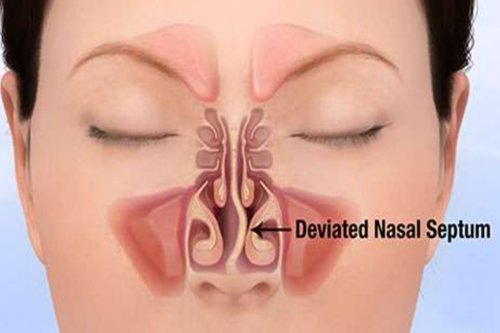Brain and ENT Clinic – Dr Lalit Mahajan In Nagpur & Dr Rachna Gangwani Mahajan In Nagpur
Deviated Nasal Septum

A deviated nasal septum occurs when the thin wall (nasal septum) between your nasal passages is displaced to one side. In many cases, this condition doesn’t cause noticeable symptoms or problems. However, when the deviation is significant, it can block one side of your nose and reduce airflow, making breathing difficult. The deviation can be present at birth or result from an injury or trauma to the nose.
A healthcare provider can diagnose a deviated nasal septum through a physical examination of the nose and nasal passages. In some cases, imaging studies like a CT scan may be recommended.
Symptoms of Deviated Nasal Septum
- Nasal Obstruction: One nostril may be more obstructed than the other, leading to difficulty breathing.
- Nosebleeds: The exposed nasal septum may be more prone to drying and bleeding.
- Sinus Infections: Difficulty draining mucus from the affected side may increase the risk of sinus infections.
- Facial Pain or Headaches: In some cases, individuals may experience facial pain or headaches, especially if the deviation affects sinus drainage.
Treatment for Deviated Nasal Septum
Nasal Decongestants:
- Over-the-counter nasal decongestant sprays or oral decongestants may help reduce nasal congestion and improve breathing. However, prolonged use of nasal decongestant sprays is not recommended as it can lead to rebound congestion.
Nasal Corticosteroids:
- Prescription or over-the-counter nasal corticosteroid sprays can help reduce inflammation in the nasal passages, alleviating symptoms such as congestion and nasal blockage.
Antihistamines:
- If allergies contribute to nasal symptoms, antihistamines may be recommended to manage allergy-related congestion.
Septoplasty:
- Septoplasty is a surgical procedure to correct a deviated septum. During this procedure, the surgeon straightens and repositions the nasal septum. This can improve airflow and alleviate symptoms such as nasal congestion. Septoplasty is usually performed for more severe cases or when conservative measures are ineffective.
Turbinate Reduction:
- If the turbinates (structures on the sides of the nasal passages) are contributing to nasal obstruction, a healthcare provider may recommend a procedure to reduce their size.
Functional Endoscopic Sinus Surgery (FESS):
- In some cases, FESS may be performed to address both the deviated septum and sinus issues. This procedure can help improve nasal breathing and alleviate sinus symptoms.
Balloon Sinuplasty:
- This is a minimally invasive procedure that involves using a balloon catheter to open blocked sinus passages. While it is not specifically designed to correct a deviated septum, it may be combined with other procedures to improve overall nasal function.
